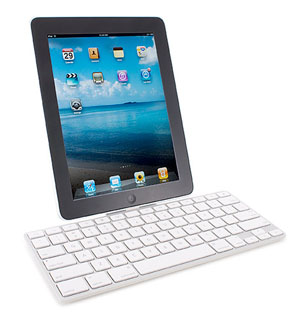 |
As regular readers know, Jeanne and I blogged heavily at TheServerSide Java Symposium 2011, writing over 30 articles in a three-day period. What we may not have had time to mention is that we both did so entirely from a pair of Apple iPads. Below is a summary of some of things I learned during my experience. |
1. Set up and Blogging Software
For my blogging spree, I used an Apple iPad 2 with an Apple Wireless Keyboard. I started with the WordPress iPad application, but found it too frustrating to use. The local/remote saving of articles was problematic, as Jeanne explains, and the interface felt very last-minute and cheap. I had three options remaining for blogging: the WordPress web interface in Safari, word processing software such as Apple Pages, or a plain old text editor. Since Internet was unstable at the conference, the first solution was out. I also vetoed fancy word processing software, since in the end the articles would be copied as plain text to the web browser for publishing. I settled on a plain text editor and was pleasantly surprised that my document management app, GoodReader, doubled as a text editor.
2. GoodReader as a Live Blogging Software
I liked blogging in GoodReader right away because it presented me with a full-screen text editor and my documents were always saved locally. I wrote up dozens of articles in GoodReader and then pasted each article into the WordPress web browser editor for publishing, which only took a minute. The only downside of using GoodReader was in the creation and naming of new files. By default, new text files are saved as “New File.txt”. In order to change the name of an article, you have to exit out of writing, open the file management interface, select the file, rename it, close the file management interface, and re-open the file. I would have preferred a more direct approach, such as offering me the chance to name the file when I created it. Also, a spell-checker after I had finished typing would have been nice.
3. iPad + Keyboard
Prior to this conference, I had never used my iPad with a keyboard. After writing thousands of words with the wireless keyboard, I can honestly say I would never go back to touch-typing for blogging. With the keyboard, the iPad became much closer to a real laptop — or more accurately a netbook — but was much smaller, lighter, and lasted a lot longer on a single charge than my full-sized MacBook Pro.
Advantages:
- Easy access to special characters such as @, #, $, often used in developer presentations. Also easy access to HTML brackets for writing HTML tags quickly.
- Arrow keys for easy navigation, particularly on web-pages with missing scroll bars. Side note: Jeanne discovered you can use two fingers to scroll in HTML windows with missing scroll bars.
- Command-Up and Command-Down worked as Home/End keys moving the cursor to the top/bottom of the window.
- Special keys give instant access to control brightness to prevent people from viewing what I write if I wanted to check my mail.
- I could type faster with fewer mistakes; tactile feedback means I don’t need to look at my hands while typing.
- Shortcut keys! I never realized how much I relied on Copy/Paste/Cut/Select All while writing until they were taken away!
- Shortcut to show/hide on-screen keyboard using the eject button.
Limitations/Notes
- Turn off AutoCorrect. On a keyboard mistakes are far less common and AutoCorrect often makes mistakes with technical words. Rejecting AutoCorrect suggestions interrupted typing and slowed it to a crawl since it required an on-screen click.
- No Command-F for find, much needed feature.
- Command-S for saving with the application. Had to touch the screen to save. This is more likely a limitation of the software than iOS, although it’s difficult know for sure.
- The Apple Wireless Keyboard desperately needs an “Off” switch. I had a lot of issues on the final day with putting the iPad in my bag only to discover later that the battery had been drained by 10% when I wasn’t using it due to the keyboard waking up and activating.
Conclusion
I loved typing with an iPad, so long as a wireless keyboard was available. Contrasting this to JavaOne two years ago, where I had to go from presentation to presentation hunting power outlets because my MacBook could barely go half the day without power. I could honestly see taking it to business meetings and typing for hours on it. While there are still some additions I’d like to see to iOS, such as Command-F for find, the experience was quite enjoyable.
